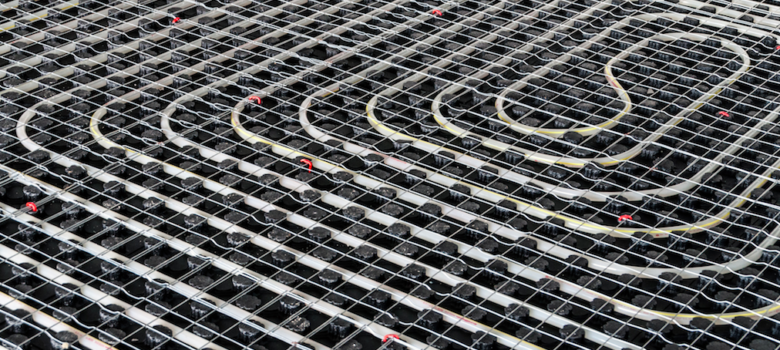
What is underfloor heating?
Underfloor heating (also known as radiant heating) has been in operation for many thousands of years. Roman Britons used hypocausts, which involved suspended floors under which fires were lit, which then heated the floor and in turn heated the baths or rooms. A network of small pipes was used to run hot air from a central furnace and heat up the building. This created a warm air convection which heated up the main living space.
Things have moved on slightly since, but radiant heating is a great economical way to heat many areas of the home. There are now two preferred methods of underfloor heating for the home: electric under floor heating systems or hot water flowing in pipes just underneath the floor surface, known as hydronic systems.
Read on to find out about the different types of underfloor heating system.
Types of underfloor heating system
Modern underfloor heating systems use either electrical resistance elements (‘electric systems’) or fluid flowing in pipes (‘hydronic systems’ – see ground source heat pumps) to heat the floor. Either type can be installed as the primary, whole-building heating system or as localised floor heating for thermal comfort in a particular room.
Electric underfloor heating systems
Electric underfloor heating systems work by using electrical resistance elements. When the system is switched on, the system gets warm, heating the wooden, tiled or carpeted floors above it. The floor then acts as a large radiator; hence underfloor heating is sometimes known as radiant heating.
This form of underfloor heating is very easy to install, and also it is very thin (in comparison to the Hydronic systems), so you will not lose any height from your rooms if you retrofit this technology within your home. Also the electrical resistance elements that make up the system run at 100% efficiency, so all the electricity that runs through them is turned into heat. The electric system you install will depend on the size of the room and type of flooring, but options include heating mats (rolled out to cover large areas), electric cable systems, or loose fit wiring flexible enough to fill more awkward spaces.
Most electric underfloor heating systems are straightforward to install, assuming that you are reasonably competent at DIY. However all electric heating systems installed in the home must be signed off by a competent electrician under the 2005 Part P building regulations.
Hydronic underfloor heating systems
Hydronic underfloor heating systems rely on hot water heated within a boiler system (or via a Ground Source Heat Pump or an Air Source Heat Pump) to provide the heat to warm the floor and the associated room. The hot water flows through pipes situated beneath the floor level which then heat the floor. As the heat is being given off by a larger area (the entire floorspace), it does not need to be as hot as the water flowing through radiators, as it is more evenly distributed within the room.
Unlike the electrical underfloor heating systems, hydronic systems will cause you to lose some height of the room if they are retrofitted (as there are pipes that carry liquid – which have a thicker profile than wires). This is the ideal technology to put in at the same time as replacing an existing floor though (please also fit Floor Insulation when you do this). In addition, unlike the electric systems, we suggest that you bring in a certified underfloor heating engineer to install this type of system.
One of the major advantages of hydronic underfloor heating systems is that they can also be used to cool a room in the summer. Unlike the electric systems, if you pump very cold water through the pipes, it will cool the floor and work in the exact reverse process, cooling the room.












I am looking for an underfloor Hydronic combined heating and cooling system that can operate on a flat roof for a 200m2 house. The system must be able to use solar for heating and, if possible for calling through a heat exchanger. Please advie who makes such a system?
Hi John, any reason you want it on the roof?!
Regardless, any good heating engineer should be able to do this for you. With solar heating you will need a dual coil hot water tank (so it can take hot water from two feeds – normally boiler + solar thermal).
Great breakdown of what underfloor heating is, thanks.
Hi I would like some advice on which UFH mat is the best in a cold room. Thank you